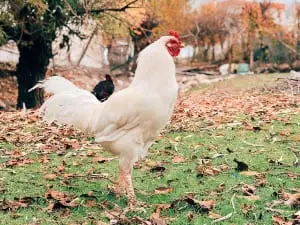
A chicken’s legs don’t look too sturdy and strong but they actually are quite sturdy and strong.
If you notice that one of your chickens has gone wobbly then this article will help you figure out why and what to do.
Table of Contents
Wobbly chicken
A variety of illnesses, diseases, ailments, and conditions can cause a chicken to go wobbly and even turn lame. Here are possible reasons why this may be happening:
Botulism:
Botulism is caused by the Clostridium botulinum bacteria. When this bacteria is allowed to reproduce, the bacteria release a deadly neurotoxin that poisons the bird.
A bird who is exposed to this neurotoxin will wobble because the neurotoxin causes the bird to lose control of its limbs. In addition to being wobbly, the bird won’t be able to hold its head up, and its wings will drop.
What to do:
The first thing that you’d need to do is isolate the sick bird. Keep the bird in a small cage, dog kennel, or cat carrier and place it in a warm and dimly lit room away from the other birds.
Give the bird antibiotics from the vet as well as vitamins as treatment. Also, make sure that you give the bird nutrient-rich food and clean and fresh water during its recovery.
Mareks disease:
This disease is caused by the herpes virus, it can develop in both young and older chickens but it is more common in younger birds and is a big issue in the chicken community.
One of the main symptoms of Marek’s disease is paralysis, if your chicken starts to wobble then this may be the beginning stages of a bird that is about to become paralyzed.
Other signs of this disease include a change in weight, irregular-looking eyes (grey eyes), a pale comb and wattle, depression, dehydration (shrunken combs), and eventually, paralysis.
What to do:
There is no treatment for Marek’s disease in chickens. Vaccinating your healthy birds against this disease is recommended but this needs to be done early on when the birds are one day old.
Thiamine deficiency:
A thiamine deficiency in chickens leads to a disease called wry neck.
Thiamine plays an important role in the production of energy from glucose.
If thiamine isn’t available then birds will not have energy. A variety of systematic problems will develop because of this, problems including a loss of muscle control.
This lack of muscle control can cause the bird to wobble because it is losing the ability to sit and stand upright. Other symptoms of this ailment include general weakness, a loss of appetite, frequent convulsions, and head tremors.
What to do:
Keep the sick bird away from your other birds by isolating the bird in a dog kennel, a cage, or a cat carrier. Make sure that the enclosure is kept in a warm quiet place with dim lighting.
Add additional thiamine to your bird’s diet, you can add thiamine into the birds drinking water or give the bird dietary thiamine
Bumblefoot:
Your bird may be wobbling because it was injured at its foot and now has bumblefoot.
If the underside of your bird’s foot was scratched, cut, or opened in any other way then bacteria, namely the staphylococcus bacteria, may have made their way into the opening under the bird’s foot.
This bacteria may have caused a pus filed abscess to form under the bird’s foot and this may have turned into an abscess. This condition is called bumblefoot.
A bird who has bumblefoot may be wobbling because walking is painful.
What to do:
You can treat the bird’s bumble foot at home if you choose to, or, you can have a vet treat the bird.
If you decide to treat the bird at home then you’d need to first soak the bird’s foot in Epsom salts and warm water, or, in warm water and betadine.
After soaking, scrub the bird’s foot to soften the tissue and then kill the bacteria using chlorhexidine 2%.
Remove the scab and squeeze out any pus from the bird’s foot. Treat the wound with Vetericyn Plus Poultry Care and then wrap the bird’s foot.
Spraying Vetericyn on the area and redressing the wound daily is recommended.
Watching a video on how to do this is also highly recommended
Scaley leg mites:
Your bird may be wobbly because it has scaley leg mites.
Scaley leg mites are parasites that dig under the scales of your bird’s legs, live under the bird’s scales, and then reproduce and poop under the chicken’s scales causing the bird’s scales to look scabby and crusty.
This not only looks uncomfortable, it is uncomfortable, and it will cause the bird to have a difficult time walking thus making the bird wobbly.
What to do:
There are commercial sprays that can be used to treat these parasites, you can treat your bird using these. The sprays contain active ingredients that will kill your bird’s scaley leg mites.
Petroleum jelly can also be used on your bird’s scaley leg mites, petroleum jelly is helpful as it suffocates the mites.
If you enjoyed this article then you may also be interested in other chicken related articles. Here are some articles that you may be interested in: Hard Lump In Chickens Throat, Chicken Cremation, Chicken Not Moving But Breathing, Chicken Having A Seizure, Sling For A Chicken With A Broken Leg

